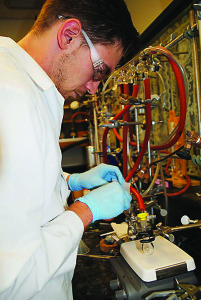Students and Faculty Work Side by Side
While most students spend their summer sitting by the pool, traveling, or working, this summer a group of students spent their summer on campus, conducting research and experiments.
Physics professor Mark Yuly, helps lead and guide students through research each summer.“It’s a time when professors and students can work on research projects during the summer… and stuff.” Yuly laughed. “It’s nice, because during that time—during the rest of the year, professors and students are still working on research, but in the summer you can really focus.”
According to its webpage, the Summer Research Institute (SRI) allows students “to interact with faculty in a much more collaborative sense than in the classroom setting” through research in physics, chemistry, biology, math or computer science. This research ranges from studying genetic modifications in influenza viruses, to exploring spam message detection on Twitter.
 Yuly has been involved with the SRI since it began, writing the initial proposal for the program. He then worked with computer science professor Wei Hu to make the SRI a reality.
Yuly has been involved with the SRI since it began, writing the initial proposal for the program. He then worked with computer science professor Wei Hu to make the SRI a reality.
Hu is the director of the SRI. He coordinates the research projects, in addition to doing his own research with students each year. Hu said he and Yuly met with Ron Oakerson, the Dean of the College, in 2006, and received approval to launch the program in 2007.
Seniors August ‘Gus’ Gula and Thomas Eckert worked with Yuly this summer on research involving inertial confinement fusion (ICF). Yuly explained ICF as a process “when you take a little tiny pellet of nuclear fuel and hit it with laser beams from every direction.” This results in an implosion which is incredibly dense and hotter than the core of the sun.
Unfortunately, the scientific instruments which may be used to study the implosion are too delicate to withstand the experiment. Therefore, as an alternative, scientists “put a piece of carbon in [the test chamber], a piece of graphite, and the neutrons that are coming out of the explosion cause the graphite to undergo a nuclear reaction.” This can hopefully be used to determine what happened inside the implosion, said Yuly.
For this technique to work, scientists need to know “how likely it is that a neutron would interact with the graphite and not just go right through it,” said Yuly. Until recently, no one knew what that likelihood was, so Yuly and his two students spent the summer finding out.
Yuly’s days at the SRI started early. “A typical day for me would be to get here at 5:30, and work for a couple hours before Gus and Thomas came,” Yuly said.
Once the students arrived, they would meet with Yuly to review their plans for the day. Each student had a focus area, tailored to their individual strengths. “Thomas mostly worked on simulating the experiment using computer codes,” said Yuly. “Gus primarily worked on collecting data.”
The objective of the research project, according to Yuly, was gradually tweaking and improving Eckert’s simulation, so it coincided with the data Gula collected. Yuly said by the end of the summer, all the collected data, aside from one set of results that Yuly is “still not completely sure” about, aligned with the final simulation Eckert had created.
For science students interested in going to graduate school and someday carrying out their own research, hands-on experience during undergraduate school is crucial, said Yuly. “You won’t get [research experience] in a graduate school unless you have some experience that you can point to.” he said. Yuly said the reason graduate programs want students with hands-on experience is because it teaches them key skills that will help them in later research.He said, “You learn a lot of things that you wouldn’t learn just by taking a normal class or listening to a lecture.”
According to Hu, faculty members benefit from the program, as well, “Our SRI faculty learn how to work with students in research, which is not possible in a standard course work.”
